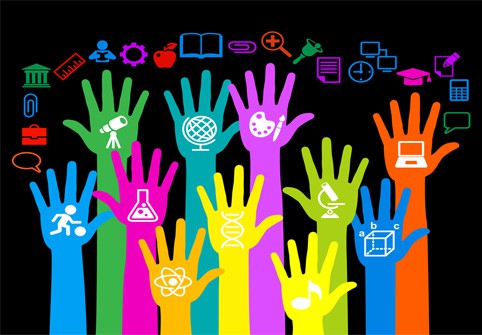Blended Learning Can Improve Working Conditions, Teaching & Learning

Teachers have tough jobs—lots of kids and lots of responsibility—and budget cuts are making things worse. They have administrators telling them to boost achievement and personalize learning, but most of them are on their own without tools. Yet, that is beginning to change as schools are beginning to blend traditional teaching with online learning.
Blended learning is a shift to an online environment for at least a portion of the student day made to improve learning and improve conditions for students and teachers. In two important ways, this definition is different than layering computers on top of how we’ve always done things. First, this definition of blended learning means that technology is core to instructional delivery and it incorporates some student choice over time, location, and/or rate. Second, it requires staffing strategies that leverage talent with technology.
Blending the best of online and onsite learning can work better for students and teachers. Building on a similar blog from last year, the following are 15 ways that blended learning is beginning to improving working conditions, teaching and learning.
5 ways blended learning can improve working conditions:
1. Teams: Blended learning is a team sport. It allows an instructional team to work together to support hundreds of students moving at their own pace. Teaching teams can increase the support provided to new teachers. Blended learning can make learning more social and more transparent.
2. Recommendations: Smart recommendation engines and lesson sharing platforms breakdown the isolation of teaching by allowing smart tools and smart colleagues to offer recommended learning experiences for groups of students.
3. Personalized PD: Platforms like Bloomboard and LearnZillion provide a personalized learning experience for teachers. All the benefits of personalized learning that apply to students will increasingly apply to teachers with multiple ways to learn and practice. Social learning platforms like Edmodo power professional learning networks across districts and around the world.
4. Career options: Blended learning is creating a new generation of school models that gives teachers more options of teaching environments. As more students combine online and onsite learning, teachers are increasingly able to choose from a variety of employers and working conditions. Team-based environments are creating more leadership roles in schools. Specialists are able to work from home and set their hours.
5. Earning potential: New staffing patterns, new roles, and extended learning time will allow many teachers to earn more than is typical today.
5 ways blended learning can improve teaching:
1. Diagnostics: Adaptive assessments like i-Ready and NWEA’s MAP can quickly zero in on learning levels. Aided by lots of content-embedded assessment, comprehensive portable learner profiles will share information with everyone involved in promoting an individual student’s growth—providing similar benefits to electronic health record in medicine.
2. Analytics: Teachers that have signed up for MangaHigh can assign free middle grade math games as homework and review a full achievement dashboard in the morning. Students that Write to Learn get instant writing feedback and the teacher gets a standards based gradebook full of evidence. In addition to extended access and more variety, the shift from print to digital curriculum will includes embedded assessments and powerful dashboards that will allow teachers to more easily monitor student progress.
3. Extended reach: With the help of a team, master teachers can reach twice as many students. At Carpe Diem, master teachers lead workshops for 300 secondary student. With the help of online learning, a great physics teacher can reach reach hundreds, perhaps thousands of students.
4. Dynamic scheduling: At School of One, when students participate in small group instruction, it’s the right lesson, on the right day, in the right modality for each student—and that’s scheduling magical. With the shift to competency-based models where more students will be moving at their own pace, scheduling software will become an important teaching tool.
5. Focus on higher order skills: At Rocketship Education, students spend about two hours each day doing online skill building exercises. That allows teachers to spend more class time on critical thinking and problem solving. Online writing assessment allows teachers to focus on the logic of an argument rather than grammar and word choice. Blended learning makes it easier to ‘flip the classroom’ and send home a playlist of instructional resources that deliver content so that class time can be spent solving problems.
5 ways blended learning is benefiting student learning:
1. Motivation: Students learning in different ways for different reasons. Blended learning makes it easier to provide multiple learning strategies. Some online learning curriculum make a point of teaching each concept three ways. The new developmental math courses from the National Repository of Open Content feature a variety of strategies for each sub-skill including instructional videos, tutorials, voice-over-text, and games. More engaging and more personalized content will help more kids learn difficult topics.
2. Self directed: By definition, blended learning creates some level of learner control. For many students the ability to make some choices about what to study, how to approach a topic, when and where to learn can make a difference.
3. Customization: EdTech enables personalized learning pathways. Visual learners and students with limited English benefit from game-based approaches like ST Math. Adaptive software like Dreambox and i-Ready build engaging and efficient pathways–that means more learning per hour.
4. Extended day: Rocketship features an eight hour student day—something they can afford only do by incorporating a two hour learning lab. Another option is an afterschool blended learning partnership with a community-based organization. The combination of CBO extensions and blended learning have the potential to double productive learning time for the students that need it most.
5. Extended year: Blended learning can help extend the school calendar. If a school operates with two less teachers and spreads pay over the other 18 teachers, they may be able to shift to a 195 day school year. They can also extend the school calendar and add more breaks that become periods for extra academic time and/or enrichment—some of which can be provided by community based organizations. Blended learning often incorporates take home technology and that means more families connected to quality learning experiences.
The “decade of deficits” is pushing more schools to figure out how to do more with less. Online and blended learning can expand options, extend access to quality, boost achievement and improve working conditions for teachers.
Bloomboard, Edmodo, and LearnZillion are portfolio companies of Learn Capital where Tom is a partner. Curriculum Associates and MIND Research Institute are Getting Smart advocacy partners.




carolyn buletza
As I looked over the many benefits making learning more engaging and more personalized content will help more kids learn difficult topics. The idea of onsite and online takes away the limits of time in the class or at school. A student can easily work on a self paced plan to complete the assignment or find other sources to increase the research base.
Sandy
This article helped me think about not only how BL and on-line learning benefits students, but teachers and the school as well. The shift is a big one, but can provide HUGE benefits- mostly from shifting the responsibility of learning from the teacher to the student. Good LM Systems are critical to this shift.
Randy Brown
I appreciated this article because it enumerates benefits of different facets of the blended learning model. I am fairly new to blended learning and this explanation helps to clarify some of the previous year's learning and my hopes and goals for this coming year.
Rachel Schowalter
I appreciated how this post broke down the different benefits of Blended Learning. I find Blended Learning a fantastic opportunity for teachers to push their students to go deeper. I also love Blended Learning as it allows students to work at different paces, which we know is best practice.
In one of my classes, we work together on big concepts on Monday and possibly Tuesday, then the rest of the week is working through the curriculum and research online at their own pace. I am enjoying this format as it gives them a chance to do group work, for me to teach bigger concepts, but then allows the students to go in slightly different directions or work at different paces on their own.
The hard part I am finding is in implementing BL, especially the 'at home' part. I love the idea of students being able to do more prep work at home in order to allow time in class for other activities. The hard part comes when all classes send that much prep work home, the students can get lost in the homework. This is also a problem in my community as internet is very spotty in town and many students do not have very strong internet. You then combine this with Sports practice or FFA or 4H in which a majority of students participate. They frequently do not get home before 7pm. This leaves little time for homework and hopefully dinner. But I am looking forward to finding better ways to implement BL more fully, especially in my more traditional classes. As it is my first year in this position, I am still figuring out what lessons I want students to do and how to implement the lessons. So it is hard for me to let students get too far ahead in the online program as I am not sure of the purpose of some of the assignments myself. But I believe, especially after this year, I will be able to more fully implement BL in all of my classes.
Nicole Boettcher
This had a lot of positive feedback about blending learning. Teamwork, open schedules, extends days/years, motivation improves, goal setting, etc. So many good reasons to do blending learning, but it is those little things (or sometimes big things) that can get in a way of teachers trying it out.
Nicole Boettcher
Alfredo Castro
This article has given me the insight of the benefits students and teachers will experience the classroom. Blended Learning can be used in the classroom and creates an atmosphere of collaboration in small groups. I can envision how I can implement blended learning with my 1st-grade students during the
English Language Arts centers.
Oscar
Thanks for sharing. Always starts on diagnostic but I go first on low order skills and gradually goes up to higher learning.